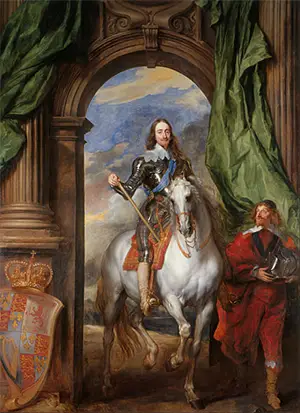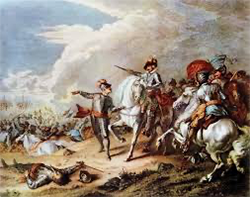King Charles I of England
Part 3: Civil Wars Before Parliament assembled, however, English voters cast their ballots in a parliamentary election. A strong majority of anti-Charles MPs were among those in session when Parliament opened. They made the most of their rejection of Charles's appeals for military funding and other measures and, instead, set about introducing measures of their own that strongly voiced their disapproval of Charles and his conduct. This resentment was primarily in the House of Commons, the lower house of Parliament. Charles still had support in the upper house, the House of Lords. All the same, Charles decided that he didn't need Parliament anymore and dissolved it. It was less than a month in session and came to be called the Short Parliament. Emboldened by Charles's failure to secure funding for his northern war, the Scottish Parliament declared itself effectively free of the king's reach and a Scottish army crossed into Northumberland. Charles went back north to take charge of the army. Scotland defeated England at the Battle of Newburn and solidified their control of English territory in the north. Charles called a great council of peers, whose advice was to sue for peace. Charles reluctantly agreed and then summoned Parliament again. This latest Parliament, which came to be known as the Long Parliament, set about opposing the king in a very meaningful way by bringing about impeachment charges against Charles's lead advisors, including his principal advisor, the Earl of Strafford, and Archbishop William Laud. To cover its bases, Parliament passed the Triennial Act, requiring the king to summon Parliament at least once every three years and providing for a secondary issuance from a parliamentary council if the king refused. 
Amongst all of this political upheaval, the people in Ireland chose to rebel, civilly and militarily. Charles and Parliament disagreed over who was in command of whatever English army would be sent to Ireland. Parliament convicted Strafford of high treason and condemned him to death. Charles, who had personally promised never to do so, signed his death warrant. Parliament had, in November 1641 under the leadership of John Pym, issued the Grand Remonstrance, a long list of offenses by the king and his ministers against Parliament and the people that dated to the beginning of his reign. Charles responded in devastating fashion the following January by marching into Parliament with an armed guard and demanding the arrest of five members of the House of Commons (including Pym) and one member of the House of Lords. The intended prisoners had been tipped off, however, and were not in Parliament when Charles and his soldiers arrived. Charles left empty-handed, but his actions convinced even some of his strongest supporters that he had breached one too many conventions. Never before had an English monarch entered the House of Commons without an invitation, and the presence of armed soldiers was a compounding of the offense. Parliament responded with a precedent of its own, passing the Militia Ordinance, which gave the responsibility of appointing militia commanders to Parliament, not the king. Charles, naturally, refused to give his Royal Assent for the bill, but Parliament declared the ordinance in effect anyway, the first time ever that a law was declared valid without Royal Assent. Parliament took control of London, which had been against Charles for a time anyway, and the king went to Hampton Court Palace, then Windsor Castle, and then north, to try to find an army that would defend him. In broad terms, Charles enjoyed support in northern and western England and in most of Ireland and parliament had support in southeastern England and Scotland. The king got plenty of soldiers to fight for his cause. The same was true for the leaders of Parliament, with Robert Devereux, the Earl of Essex leading the way. Both sides took up arms in earnest, and the English Civil Wars began. 
The first sustained battle took place at Edgehill on Oct. 23, 1642. Charles put his trust in his nephew, Prince Rupert of the Rhine, rather than his military commander, Lord Lindsey, who promptly resigned his post. Lindsey still fought in the battle and died from wounds he sustained. Neither side gained the upper hand on the battlefield, and darkness ended the fighting. Not for the last time, the king and his forces regrouped at Oxford. Two weeks later, a Royalist force marched on London but, met with superior numbers, broke off its march. Charles and his forces returned to Oxford and spent the winter there. The following year, the two sides talked peace but could come to no mutually beneficial arrangement. Unlike modern wars, the pace of battle and troop movements was quite slow during this war. Weather often hindered the movement of troops and equipment, and weapons for many were hard to come by; as well, the soldiers who fought in this war were, early on, volunteers who may or may not have been paid for their service. When not marching with or fighting for the king or the parliamentary side, the soldiers were living out their lives much as they had been–farming, conducting business, and looking after their families. Small skirmish followed small skirmish, and some of these can quite rightly be called battles, but the number of major battles was quite small. Royalist forces captured Bristol in July and tried unsuccessfully to besiege Gloucester. The two forces met at Newbury on September 20, and again neither side could gain any ground; as darkness fell, both sides broke off their attacks. Charles, in January 1644, summoned a Parliament–not in London but in Oxford. About one-third of the Members of the House of Commons attended, as did many Members of the House of Lords. This was known as the Oxford Parliament. It was officially in session for more than a year but didn't contribute much to the war effort. 
The next phase featured the Solemn League and Covenant, an alliance between the parliamentary force and a Scottish army, led by the Earl of Leven. Royalist forces won at Cropredy Bridge in June but then lost at Marston Moor less than a week afterward. (Among the victors on the field of battle at Marston More was a cavalry soldier named Oliver Cromwell.) Another engagement at Newbury produced the same non-result as before; and as 1644 closed, both sides were in winter quarters and negotiating terms of a cease-fire (which again failed). In 1645, Parliament formed the New Model Army, a professional military force led by Cromwell and Thomas Fairfax. The parliamentarian leaders were having increasing difficulties convincing their militias to fight if it required roving too far from home. The strategy of using militias local to the area of the fighting had worked so far, but as the fighting ranged far and wide, the Roundheads, in particular, were having trouble raising recruits. The New Model Army offered daily pay and required its members to drill, train, and fight when told. The numbers swelled to 22,000 and were more than the Cavaliers had at their disposal at this point. The next major battle took place in June, at Naseby. The parliamentary forces scored a victory on that day and then followed that up with a string of others. In the end, Charles chose to surrender–not to Cromwell and Parliament but to Scotland. The Scottish handed over the king to Parliament for a large ransom in January 1647. Parliamentary forces kept the king under house arrest. Charles escaped to the Isle of Wight, in hopes of raising a new army and reversing his recent fortunes. He was successful at the former but not the latter. The Second English Civil War had the same result as the First, in a shorter period of time. Charles finally got his alliance with Scotland, and a Scottish invasion force entered the scene in 1648. The New Model Army was more than up to the task of defending against this new foe and won a decisive victory at Preston, in Lancashire. The parliamentary forces turned their sights on Parliament and convinced all of the remaining supporters of the king to leave. What was left was called the Rump Parliament. The House of Commons convened a high court of justice in January 1649. The verdict was that Charles was guilty of treason. The sentence was death and was carried out on January 30. First page > Early Reign > Page 1, 2, 3 |
|
Social Studies for Kids
copyright 2002–2024
David White




